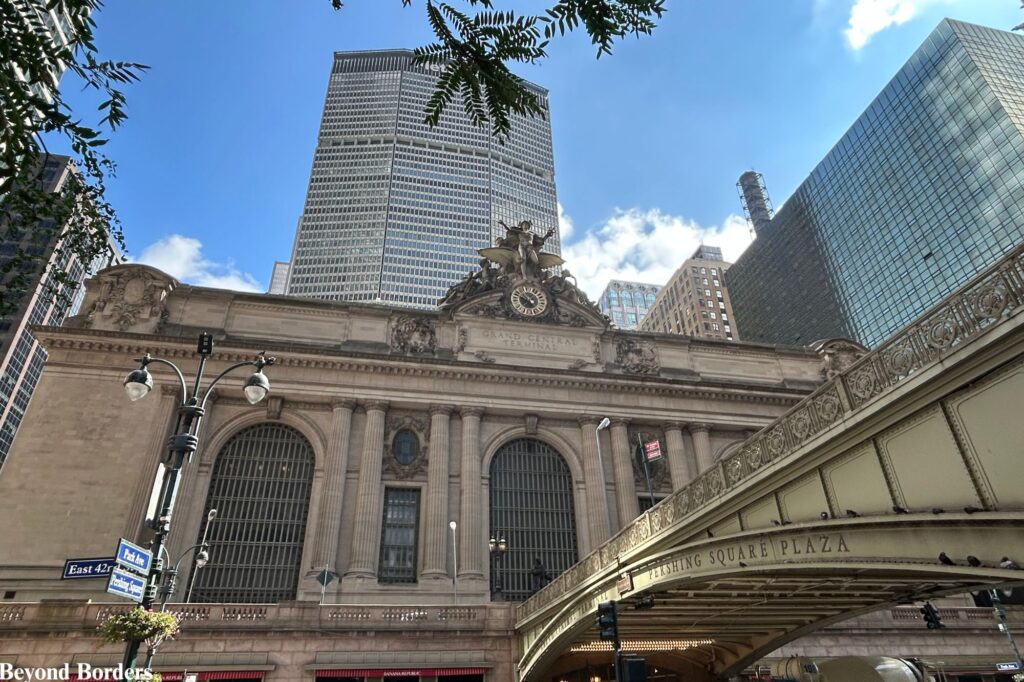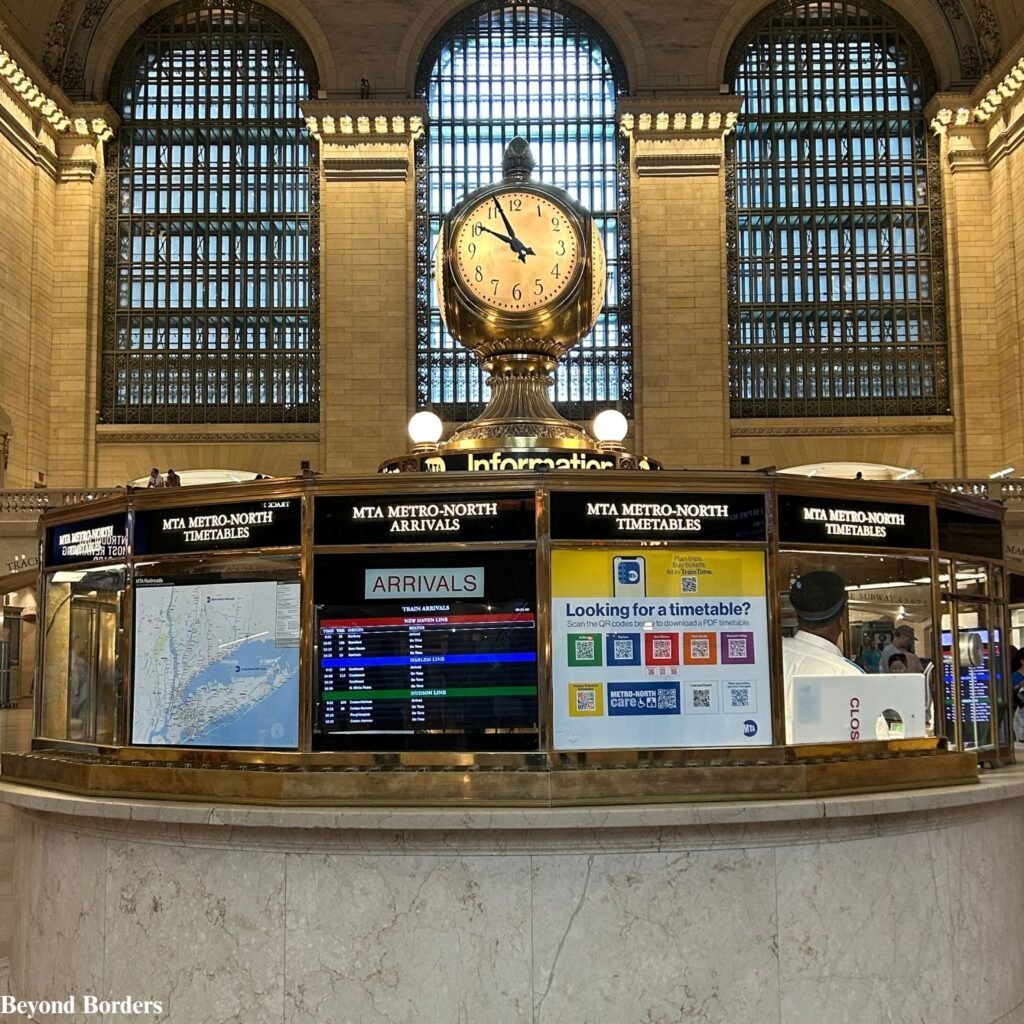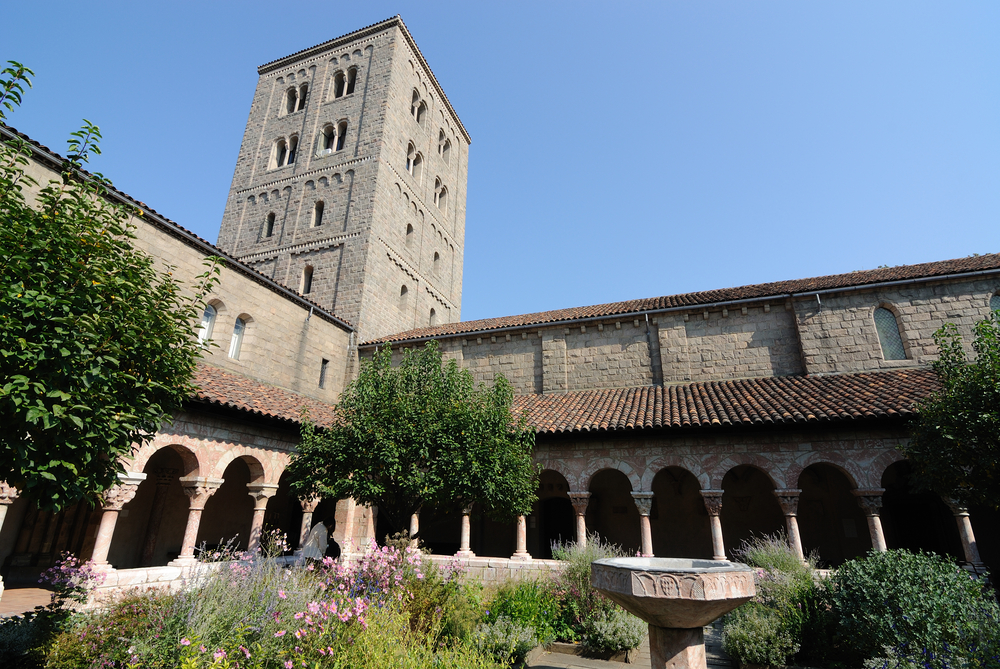Longing for a New York City experience beyond the usual hustle and bustle? While escaping the crowds entirely is challenging, New York City offers many fantastic attractions that, despite their popularity, tend to be less overrun than major draws like Times Square, the Empire State Building, or Central Park. This post will guide you through some of those spots, from a peaceful medieval art museum tucked away far uptown to a bustling Italian marketplace that’s a destination in itself. Get ready to discover a different side of New York City!
Hudson Yards
Location: Between West 28th Street and West 38th Street along 11th and 12th Avenues.
Subway stop: 34th St–Hudson Yards on the 7 train.
One of Manhattan’s newest neighborhoods, Hudson Yards is set atop rail yards and has become known for its innovative architecture, featuring the Vessel, an interactive public art piece with unique staircases, and The Edge, the highest outdoor observation deck in the Western Hemisphere, offering thrilling panoramic views of the Hudson River and a glass floor. Hudson Yards has a mix of office and apartment buildings, as well as a sprawling luxury shopping mall with over 100 high-end stores and diverse dining options. I mention The Edge observation deck in more detail in my 5 days in NYC itinerary, including prices. To purchase tickets to the Vessel, check their website here.


Little Island
Location: Meatpacking District, at 10th Ave and West 13th Street. It is close to the High Line, Chelsea Market, and the Whitney Museum of American Art.
Subway stop: 14 St/8 Ave
Opened in 2021, New York City’s Little Island is a 2.4-acre architectural marvel! It consists of 132 “tulip pot” structures of varying heights that look like they are floating above the Hudson River. The elevated design of Little Island was influenced by Hurricane Sandy (2012) and how it was designed to be resilient against future floods, while still allowing sunlight to penetrate and support the marine ecosystem below. It is free to walk around Little Island, explore the landscape, and take photos (no tickets required)! Tickets cost $25 per person for concerts held in their amphitheater.
Little Island also has diverse plant life, with over 400 species of trees, shrubs, grasses, and perennials. Its location against the Hudson River and plant life provide a unique sense of escape and tranquility from the hustle and bustle of Manhattan. Check out their website here to learn more.


Greenacre Park
Location: Midtown East
Subway Stop: Lexington Av/53 St or 51 St
Greenacre Park is a serene “pocket park” located in the Turtle Bay neighborhood of Manhattan on East 51st Street. It’s a small, privately-owned public space that serves as a tranquil urban park among the busy Midtown hustle and bustle. The most distinctive and memorable feature is a spectacular 25-foot waterfall at its rear, which cascades over a wall of granite. The sound of the rushing water is deliberately engineered to muffle the city’s noise, creating a truly peaceful atmosphere.
The park features honey locust trees that provide a canopy of shade, as well as seasonal flower beds and ivy-covered walls. It has an elevated terrace, a small cafe kiosk, and seating with movable tables and chairs, encouraging people to stay and relax and/or eat lunch. Greenacre Park is a well-maintained and elegant space, offering a quiet retreat that feels a world away from the surrounding skyscrapers of Midtown.
Museum of the City of New York
Location: 1220 5th Ave, between East 103rd and 104th streets (uptown)
Subway stop: 103rd Street
Tickets cost $23 per adult. This museum was founded in 1923 and is dedicated to the distinctive nature of urban life in the world’s most influential metropolis. It was conceived as a place to preserve the “annals and records” of the city and its people. The core mission of the museum is to explore New York City’s past, present, and future. It delves into what makes New York “New York”: its unique character, its heritage of diversity, endless opportunities, and its perpetual transformation. Besides major historical events, the museum also focuses on the everyday lives of New Yorkers, their struggles, successes, and the cultural movements that have shaped the city.
Whitney Museum of American Art
Location: 99 Gansevoort Street, 5-minute walk from Chelsea Market
Subway stop: 14 St / 8 Ave
Many visitors tend to visit The Met and MoMA during their visit to New York City, but the Whitney Museum of American Art is just as worth seeing. The Whitney is an art institution dedicated to the art of the United States, mainly focusing on the 20th and 21st centuries. It also mainly showcases works by living artists. The museum stands out for its commitment to showcasing the full range of American creativity, often embracing overlooked artists, especially those whose work may not yet be widely recognized. Tickets cost $30 per adult and are free for those aged 25 and under.

Eataly NYC Flatiron
Location: 200 5th Ave, between West 23rd and 24th streets and next to Madison Square Park
Subway stop: 23rd Street
While Eataly’s physical locations are popular attractions (the original is in the Flatiron district, but there are others throughout New York City), the full culinary experience Eataly offers is a hidden gem for visitors. Eataly is not just a restaurant, but a bustling Italian marketplace with a multitude of culinary experiences! Therefore, it is a hidden gem of experience, not location.
The “hidden” part is the discovery of all the different dining options, from the pasta and pizza bars to the fish counter, as well as the unique rooftop restaurant, SERRA by Birreria. This is a different kind of dining adventure than going to a single, dedicated restaurant. Reflecting this dining adventure, Eataly offers cooking classes, restaurants, and food shopping, reflecting their “Eat, Shop, Learn” philosophy.
Visiting Eataly is a perfect activity for a rainy afternoon or for people who want to do more than just sit down for a meal. You can grab a coffee and a pastry, get some gelato, or assemble a gourmet picnic to take to a nearby park. Additionally, if one person craves fresh pasta and another wants a slice of pizza, they can both get it in the same place without having to compromise. This is a huge selling point for groups with diverse tastes. Eataly is the ideal destination for a foodie who wants to graze and sample different things, rather than committing to a full three-course meal at one restaurant.

Tenement Museum
Location: 103 Orchard Street between Allen Street and Ludlow Street ( Lower East Side, downtown)
Subway stops: Delancey Street–Essex Street, Grand Street, Bowery
Through guided tours, the preserved 1863 Tenement Museum vividly portrays the stories of Lower East Side immigrants. The museum is a National Historic Site of the immigrants who lived in its preserved tenement buildings. The museum’s two historical tenement buildings, at 97 and 103 Orchard Street, were home to approximately 15,000 people from over 20 different countries between 1863 and 1935 (97 Orchard Street) and 1888 and 2015 (103 Orchard Street). Tickets cost $32.50 per adult.
Whispering Gallery at Grand Central Terminal
Location: Grand Central Terminal lower level in the dining concourse, just outside of the Grand Central Oyster Bar & Restaurant
Subway stop: Grand Central-42 St
New York City’s Grand Central Terminal is a world-famous landmark, but many visitors rush right past its most enchanting secret: the Whispering Gallery. On the lower level just outside the Oyster Bar, this architectural marvel allows two people to have a private conversation from opposite corners. The Whispering Gallery is created by the low arches and vaulted ceiling made of Guastavino tiles.
If you and a friend stand at opposite corners of the arched entryway, face the wall, and whisper, you’ll be able to hear each other clearly from across the space, even amidst the hustle and bustle of the terminal. The acoustic effect may have been an “unintentional” or “happy coincidence” of the design. The Whispering Gallery is also a spot for marriage proposals!


Trinity Church
Location: 89 Broadway in the Financial District
Subway stop: Wall Street
Once the tallest building in New York City (until 1890), Trinity Church is one of the earliest and finest examples of Gothic Revival architecture in the United States. George Washington himself attended services here during his time as president and worshipped at St. Paul’s Chapel (a chapel building of Trinity Church built in 1766 and the oldest surviving church building in Manhattan) on his Inauguration Day, April 30, 1789. Washington also attended services at St. Paul’s Chapel during the two years New York City was the country’s capital after the ratification of the Constitution (1789-1790). Additionally, United States Founding Father Alexander Hamilton is buried here, whose life story became world-famous thanks to Lin-Manuel Miranda’s Tony award-winning musical Hamilton.


Walk along Fifth Avenue
Location: The main shopping area on Fifth Avenue is generally considered to be between 49th and 60th Streets.
Subway stops: 5 Avenue/53 Street, 5 Av/59 Street
Fifth Avenue in New York City is the second most expensive retail destination in the world (after Via Monte Napoleone in Milan, Italy). Stores that stand out on Fifth Avenue include:
Tiffany & Co–The Landmark: The flagship location of this famous retailer of fine jewelry that underwent a massive renovation, making it a museum-like experience for jewelry and luxury goods.
Apple Fifth Avenue: The iconic glass cube entrance leading to a subterranean store, known for its 24/7 operation and unique design.
Nike House of Innovation: A multi-story experiential store where customers can test shoes on treadmills or customize products.
The Cartier Mansion: A former private home transformed into a stunning retail space, known for its history and exquisite jewelry.
The stores on Fifth Avenue are more than just stores; they are often global flagships, architectural statements, and brand showcases. Designer brands like Louis Vuitton, Prada, Gucci, Cartier, Chanel, and more use their Fifth Avenue presence to project their global image.
Walking along Fifth Avenue offers more than just seeing expensive stores. You will also see many architectural landmarks as you walk along Fifth Avenue, including:
St. Patrick’s Cathedral: A stunning Neo-Gothic cathedral
New York Public Library (Stephen A. Schwarzman Building): Has famous lion statues, “Patience” and “Fortitude”
Rockefeller Center: An Art Deco complex, especially famous for its Christmas tree and ice rink
The Plaza Hotel: A legendary 5-star hotel at Grand Army Plaza

Shopping in the Diamond District
Location: From West 47th to West 50th street (mainly on West 47th Street), between 5th and 6th Ave
Subway stop: 47-50 Sts-Rockefeller Center
The Diamond District in New York City is the epicenter of the diamond and jewelry trade in the United States and one of the most significant globally. Simply marvel at the dazzling displays in every window or consider buying something to treat yourself. What makes the Diamond District unique amongst jewelry sellers is that bargaining is an expected part of the experience when shopping here. Unlike typical retail stores with fixed prices, many of the vendors on 47th Street operate more like a traditional marketplace where negotiation is the norm. Security is paramount here, with armed guards, police patrols, and a network of surveillance cameras safeguarding billions of dollars’ worth of merchandise.
Remember these tips when considering bargaining: It doesn’t mean you’ll always get a huge discount, or that it’s a simple process. It requires some effort and knowledge. Some vendors may be more open to negotiation than others, so remember to shop around. Politeness and respect are still crucial when negotiating a sale.
Met Cloisters
Location: 99 Margaret Corbin Drive in Fort Tyron Park
Subway Stop: Dyckman Street on the A train
You’ve probably heard of The Met, but did you know a separate branch of the museum exists far uptown? The Met Cloisters offer a spectacular escape to medieval Europe that many visitors completely overlook. This museum isn’t just a collection of art; it’s a meticulous reconstruction of actual medieval cloisters, chapels, and gardens from across Europe. Located in Fort Tryon Park, the peaceful stone courtyards and vaulted halls feel a world away from Manhattan, offering breathtaking views of the Hudson River. Inside, you can admire beautiful frescoes, stand before the world-famous Unicorn Tapestries, and wander through a truly unique corner of New York City.
Tickets cost $30 per adult. As I mentioned in my 5-day New York City itinerary, it will not cost you more money to visit The Cloisters on the same day if you’ve already paid for admission to The Met. Once you purchase your ticket for one location, hold onto it (or your receipt/proof of purchase) and present it at the other location on the same day for entry.

Conclusions
While popular landmarks like Times Square, Central Park, and the Brooklyn Bridge are worth visiting, exploring the unique destinations on this list offers a chance to see a different side of New York City. You can discover a way to connect with the city on a more personal level and escape the usual tourist crowds and long lines. So, on your next trip, take a moment to explore these lesser-known spots, as they are often just as rewarding and enthralling as their more popular counterparts.

